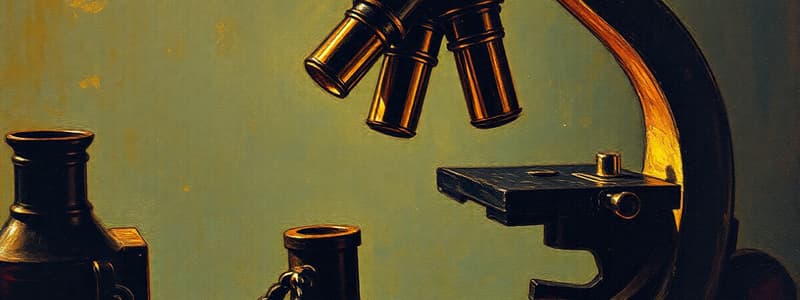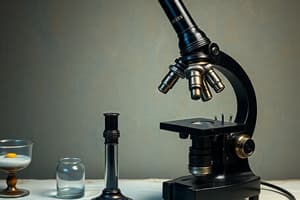Podcast
Questions and Answers
Explain why it's important to follow the correct shut-down procedure for a microscope each time it is used.
Explain why it's important to follow the correct shut-down procedure for a microscope each time it is used.
Following the correct shut-down procedure ensures the longevity and optimal performance of the microscope by preventing damage and maintaining cleanliness.
A prepared slide is being viewed under a microscope. As you switch from the yellow objective to the blue objective, what happens to the field of view, and why does this change occur?
A prepared slide is being viewed under a microscope. As you switch from the yellow objective to the blue objective, what happens to the field of view, and why does this change occur?
The field of view decreases because the magnification increases, allowing for greater detail but less area to be viewed.
If you are viewing a specimen under the red objective, what is the total magnification? Show your work.
If you are viewing a specimen under the red objective, what is the total magnification? Show your work.
40x. 4x (red objective) * 10x (eyepiece) = 40x.
Why is it important to use both hands when carrying the microscope?
Why is it important to use both hands when carrying the microscope?
Explain why adjusting the diaphragm can improve the quality of the image.
Explain why adjusting the diaphragm can improve the quality of the image.
Flashcards
Microscope Base
Microscope Base
Supports the microscope; one hand should be here when carrying.
Microscope Eyepiece
Microscope Eyepiece
Lens you look through; usually magnifies 10x.
Microscope Arm
Microscope Arm
Connects the base and head, used for carrying.
Red Objective Lens
Red Objective Lens
Signup and view all the flashcards
Microscope Field of View (FOV)
Microscope Field of View (FOV)
Signup and view all the flashcards
Study Notes
- The base is the bottom support of the microscope.
- The eyepiece is the lens you look through.
- The arm is the vertical support connecting the base and head.
- The fine focus knob allows for precise image focusing.
- Objectives are the lenses with different magnifications.
- The diaphragm controls the amount of light reaching the specimen.
- The coarse focus knob allows for large image focusing.
- The light source provides illumination for viewing the specimen.
- The stage is the platform where the specimen is placed.
- Stage clips secure the specimen slide on the stage.
- How to carry a microscope: one hand on the arm and one hand under the base.
- The magnification of the eyepiece is 10x.
- The total magnification of the yellow objective is 40x.
- The magnification of the red objective is 4x.
- The total magnification of the red objective is 40x.
- The magnification of the yellow objective is 10x.
- The total magnification of the blue objective is 400x.
- The magnification of the blue objective is 100x.
- Field of View (FOV) is what a person views or sees.
- 10x has less image, more detail.
- 4x has more image, less detail.
- Shut down procedure: 1. What is the first step?
- Shut down procedure: 2. What is the second step?
- Shut down procedure: 3. What is the third step?
- Shut down procedure: 4. What is the fourth step?
- Everything underneath the microscope is upside down and backwards.
Studying That Suits You
Use AI to generate personalized quizzes and flashcards to suit your learning preferences.




